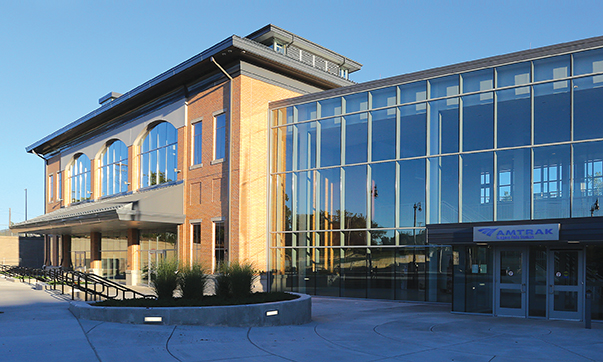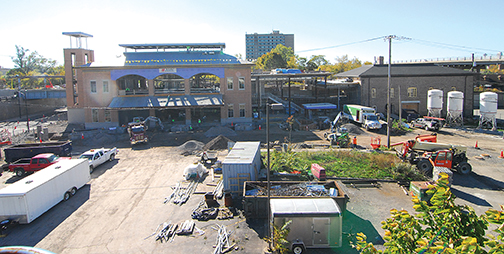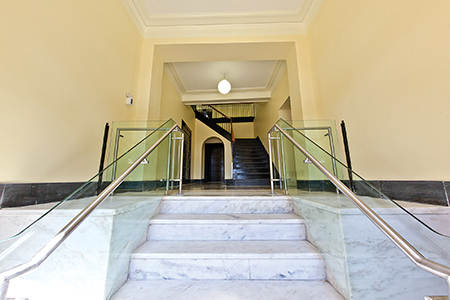
![]() Given the city’s reputation as a tourist hotspot, the City of Niagara Falls’ former Amtrak terminal seemed somewhat neglected. A former freight warehouse built in the 1970s, the building’s industrial aesthetic and remote location belied the natural wonder the city is famous for.
Given the city’s reputation as a tourist hotspot, the City of Niagara Falls’ former Amtrak terminal seemed somewhat neglected. A former freight warehouse built in the 1970s, the building’s industrial aesthetic and remote location belied the natural wonder the city is famous for.
By Richard Tackett
The city had a keen interest in renovating and relocating the facility dating to the 1980s, but persistent false-starts and obstacles frustrated the community’s efforts for the better part of a decade. Some in the planning process, which at different times included railroad companies, Amtrak, the State of New York and the federal government, questioned whether Niagara Falls, NY, would ever house a new rail station. In 1999, the city’s leadership made a do-or-die decision – take the lead on the project and push it forward, alone if need be.
“The community’s leaders, particularly the mayor and the city council at that time, were strongly supportive of this idea; that the city should take the initiative to implement the station project,” says Thomas DeSantis, senior planner for Niagara Falls. “They couldn’t over-rely on other levels of government, or other organizations, because those groups didn’t have as much ‘skin in the game.’”
“We felt that the old facility didn’t make a great impression on first-time visitors to our community,” says Niagara Falls Mayor Paul Dyster. “We wanted something to reflect the grandeur of our beautiful city.”

Relocation and renovation
DeSantis says the project truly started moving after the city secured a $2.5 million federal border infrastructure grant from the Federal Highway Administration (FHWA) and Federal Transit Administration (FTA) in 2000, intended to fund studies on relocating the facility closer to the Canadian border. It kicked off a series of small grant awards that allowed DeSantis’s team to begin planning and engineering the new station, as well as bring stakeholders like the railroads and federal government back into the loop.
“Throughout the entire process, the city involved the station’s future stakeholders in decision making,” DeSantis says. “We kept them engaged so that every party had input.”
DeSantis says that the city and the project’s other stakeholders eventually settled on the proposed facility’s main objectives. It had to be “built into” the community – central location was key. Secondly, the project and the facility itself needed to drive economic development in Niagara Falls – accomplished by leasing space for retail use or other activities. It also needed to spur increased tourism, a critical aspect of the Niagara Falls economy. Finally, and perhaps most importantly, the facility needed to function as a secure border crossing between the U.S. and Canada.
“The border-crossing element was critical, as a matter of pragmatism,” DeSantis says. “Much of the funding, and the project’s ultimate success, hinged on the success of the facility as a border checkpoint.”
The city’s Request for Proposals (RFP) to conduct the relocation study saw many firms compete in the bidding process. Niagara Falls ultimately selected Wendel Companies, a nationwide firm based out of nearby Buffalo, as the project’s primary consultant.
“We undertook the site selection process in which we reviewed eight sites around the city for a new Amtrak facility,” says Susan Sherwood, program manager at Wendel. “Niagara Falls had very specific objectives, including intermodality, and it was important for us to coordinate those objectives with the project’s requirements as a community center and a border-crossing facility.”
The selection process eventually settled on the site of the historic U.S. Customhouse, one of New York’s seven “most endangered” historic buildings at the time. Wendel and Niagara Falls selected the site based on their criteria: central location, potential for economic development, security for border crossing and capability for intermodal travel. After negotiating with the property’s then-owner and conducting an environmental review, the city purchased the building for renovation in 2001.

Photo by Bill Wippert
Expanding parameters
As the project developed beyond the site selection phase, the city awarded Wendel subsequent contracts which practically ensured that the firm would remain onboard until construction completed on the new transportation center. The city opened the project to competitive bidding every time, and Wendel won each time because of experience and capabilities.
“We worked so closely with Wendel for so long that I often had to remind myself that they weren’t city employees,” Mayor Dyster says. “At various times, we were on the phone two or three times a day, trying to sort through some of the more difficult issues. I think a project of this magnitude requires all of the effort of your city staff, and then some. Wendel provided the ‘and then some.’”
And though the project was expansive to begin with, its parameters began rapidly expanding as Wendel and Niagara Falls started working. As a result, and in addition to the consulting, design and construction the city had already contracted for, Wendel helped Niagara Falls navigate the complex landscape of federal funding, and environmental requirements associated with NYS SEQR and NEPA.
Most noticeably, the nearby U.S. Route 104 / Main Street was in very rough shape. Thanks to Wendel’s expertise in securing funding, the city was able to start solving these seemingly-disparate problems with some creative grant proposals in 2008.
“Once we got environmental clearance, we were able to secure $8 million in funding to reconstruct Route 104 – all the way from the station to the northern city line,” Sherwood says.

Ian Gattie Photography
The Wendel team then found that they’d need to rebuild and rehab the CSX Transportation railroad bridge at the site. From there, it gets interesting – the FHWA’s Transportation Enhancement Program (TEP) stipulates that if a project uses a certified-historic building for transportation purposes, that project is labeled “high-priority.” With that in mind, Wendel successfully applied for a $2.5 million FHWA grant through Senator Chuck Schumer’s office to fund the restoration and reconstruction of both the U.S. Customhouse and its surrounding bridges in 2006.
“The bones of the building were fine, but there were really no windows and the roof had caved in,” Sherwood says. “There was a lot of water in the building too, so it was rapidly deteriorating.”
“The $2.5 million was not enough money to do all the necessary work on the Customhouse,” she adds, “so we had to be very discerning, prioritizing tasks which would stabilize the building.”
The FHWA put a few requirements on the project for funding. First, the restored Customhouse must be open for public use upon completion of the rehab project. Secondly, two components of the building must be restored to their original condition – the Customhouse exterior, as well as its main corridor and lobby.
In one instance, Wendel even found that some windows needed to be restored with original, single-pane glass. That required some creativity on Wendel’s part.
Wendel and Niagara Falls completed construction on the historic Customhouse renovation in 2009, when the city did not yet have funding for the proposed new Amtrak station. Thus, each federally-funded component of the final transportation center had to have independent utility – so even if the Amtrak station never came to fruition, each of these components would have a public use and benefit all their own.
“The funding for the project came in bits and pieces over a prolonged period of time,” says Donald Gray, vice president at Wendel. “It was a phased design and construction. After each phase, the public benefit and progress was noted and we would then apply for additional funding.”
Moving toward completion
In 2010, Wendel, the city and Amtrak cooperatively wrote a FY2010 TIGER discretionary grant application for $19.9 million to the U.S. Department of Transportation (DOT). Ultimately, the DOT awarded the project $16.5 million. As a result, Wendel began to “value engineer” $3 million out of the facility construction and, at the same time, work toward obligation of the funding – something Sherwood describes as a fairly arduous process.
After long negotiations with Amtrak, the federal government and multiple railroad companies, the project received clearance to obligate the $16.5 million in funding and commence construction in 2013.
By 2014, the Customhouse restoration was complete, the new bridge was in place and U.S. Route 104 was reconstructed. All that remained, it seemed, was construction of a new Amtrak passenger station, the U.S. Customs and Border Protection inspection center (at the Customhouse) and the rail infrastructure associated with it.
Passenger station construction took approximately 24 months, and the city opened its new station for passenger service in December 2016.
The facility’s design and construction (to LEED silver standards) featured many sustainable features, which Wendel considers a crucial part of its capabilities.
Wendel took a “whole building” integrative design approach to help maximize the sustainable opportunities and operational efficiencies through the life of the building.
Energy modeling helped guide the design team to evaluate efficient mechanical systems and components. Energy systems evaluated for the project included solar thermal, solar photovoltaic, energy recovery, renewable energy, and water conservation.
Water conservation measures reduce potable water usage for the facility, native and adaptive plantings were used to eliminate the need for irrigation, and regional and recycled materials were used where feasible.
A community hub
Today, the Niagara Falls Intermodal Transportation Center is a state-of-the-art hub for tourists and commuters alike. In addition to housing the Amtrak station, it sees traffic and connections to and from city transit buses, touring buses, motorcoaches, circulator shuttles, park-and-ride users, taxis, bicyclists and pedestrians.
Currently, the facility features a continuous canopied platform, comfortable seating, Wi-Fi, real-time passenger information and vending services.
“Because the train station itself is elevated to the second story of the main building,” Sherwood says, “we took advantage of the newly-created basement space and turned it into 4,400 square-feet of retail space. The city is working right now to fill that space with suitable vendors.”
As a community center, the station’s main lobby has plenty of space for events by the city – and it’s adjacent to a beautiful amphitheater with a fabric canopy-covered stage.
“We’re looking to hold shows, vignettes, lectures and other events in the amphitheater, when the weather is nice,” DeSantis says. “It’s purposely built to serve that function, and we believe it will work wonderfully.”
The Underground Railroad Historic Commission is outfitting the first floor of the historic Customhouse as the Harriet Tubman Underground Railroad Museum, due to the area’s significance as a former stop for slaves to escape the U.S. into Canada.
“We recently hosted a lecture from the Michigan Freedom Trail Commission, all about the history of the Underground Railroad in Niagara Falls,” DeSantis says. “It really demonstrated the community value this transportation center presents.”
More than anything, city officials and consultants say the construction of this transportation center has finally re-aligned the magnificence of Niagara Falls with its stop on the Amtrak trail.
“As time goes on, this station will increasingly become a point of pride for our community,” Mayor Dyster says.
“It’s brought a huge opportunity for economic development to the city, that we wouldn’t have otherwise had,” Sherwood, a Niagara Falls area local herself, says. “It connects us with the greater Toronto area while also increasing border safety.”
“This station is now commensurate with the idea of Niagara Falls as a world-class tourist attraction,” Gray says. “People come here from Canada and across the United States, and this station will help to give them an extremely favorable impression of Niagara Falls, NY. It’s a jewel, and it’s something in which the community can take pride”
